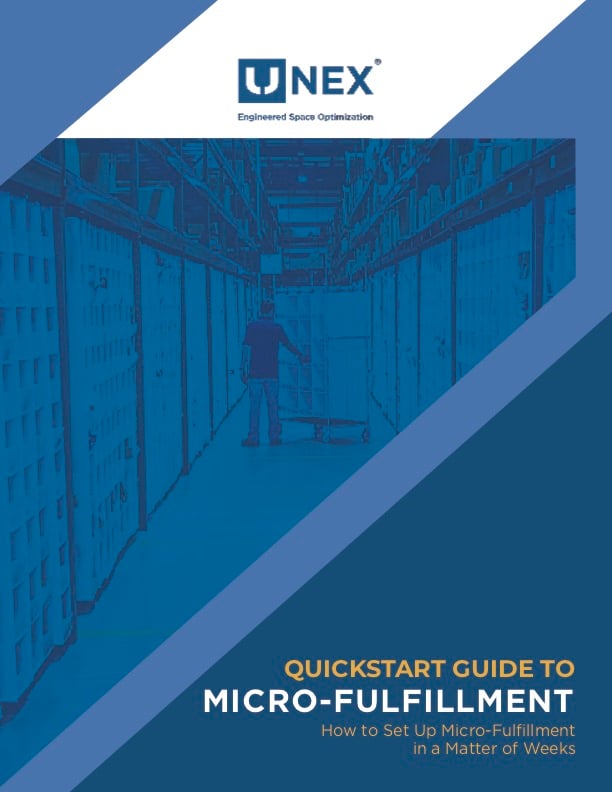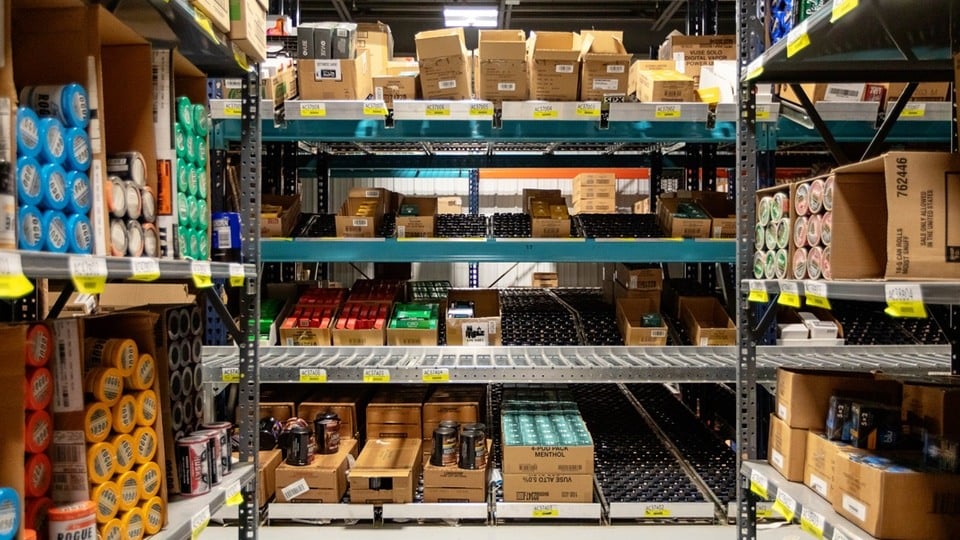Optimizing Micro-Fulfillment Centers with Dynamic Storage Solutions

Key Takeaways
- Static racking limits efficiency in micro-fulfillment centers, where SKU density and fast access are essential.
- Dynamic storage systems maximize space, streamline workflows, and support fast re-slotting in high-volume, compact environments.
- UNEX SpeedCell, SpanTrack, FlowCell, and SpeedCartt boost SKU accessibility and picking speed in micro-fulfillment operations.
Micro-fulfillment centers (MFCs) are quickly changing the way brands deliver products to consumers. As online ordering becomes the standard shopping method in everything from retail to grocery and pharmaceuticals, more companies are turning to these compact, strategically located warehouses and fulfillment spaces to more efficiently deliver high-demand goods to consumers.
Driven by real estate constraints, labor shortages, and shifting consumer expectations for fast deliveries, MFCs are quickly taking over the last-mile logistics landscape. A full 61% of customers say they want the option to get items delivered within one to three hours of ordering, and micro-fulfillment helps brands make this possible. Unsurprisingly, the market value of MFC software is set to double between 2022 and 2030, as brands shift from traditional, centralized fulfillment to localized, flexible solutions designed for speed and density.
But software alone isn’t sufficient to ensure an MFC delivers real value, even when paired with automation. As in any fulfillment environment, efficiency starts with a well-organized warehouse, and that puts micro-fulfillment storage solutions front and center.
The Critical Role of Storage in Micro-Fulfillment Center Success
MFCs are compact warehouses or fulfillment centers built close to customers (or even carved out within existing retail spaces) to enable rapid order fulfillment. They rely heavily on automation and efficient workflows to maximize throughput in tight spaces. But while automation tends to dominate the conversation, storage infrastructure is just as critical to success, and often where operations quietly break down.
Many MFCs still depend on static racking systems originally designed for the slower turnover and less complex inventory of traditional warehouses. This simple, level shelving works well for predictable B2B fulfillment cycles, but it doesn’t hold up under the pressures of modern micro-fulfillment. MFCs must manage thousands of fast-moving SKUs within small physical footprints. They’re often constrained by low ceilings and limited expansion options. In these environments, static shelving wastes valuable cubic space and limits the flexibility needed to keep up with shifting demand.
On top of spatial constraints, MFCs face a constant balancing act between manual processes and scalable automation. Teams must re-slot inventory frequently to accommodate seasonal surges, SKU proliferation, and changes in buying behavior, yet static systems hamper that kind of agility. When storage isn't optimized for high SKU density and fast access, robotic and human pickers are forced into inefficient workflows that slow throughput and inflate labor costs.
If online sellers are going to fully capitalize on the MFC model, they need storage solutions that are flexible, scalable, and built for constant change. Static infrastructure may seem simple and cost-effective up front, but on its own, it becomes a bottleneck that chokes the very speed and responsiveness MFCs are designed to deliver.

What Is Dynamic Storage and Why Is It a Game Changer?
Dynamic storage systems are uniquely suited to the speed, complexity, and constant change that define MFCs. These modular storage solutions are adaptable and made to evolve with shifting SKU assortments and fluctuating order volumes. They often incorporate gravity-fed flow racks for first-in, first-out (FIFO) inventory rotation, high-density storage solutions, and reconfigurable components that make the most of every cubic foot.
Even better, dynamic storage systems enable faster pick and replenishment cycles by improving product accessibility and minimizing the time spent traveling between SKUs. By maximizing usable space and supporting more efficient SKU slotting strategies, dynamic storage systems help reduce congestion, streamline workflows, and lower labor costs, even for high order volumes in compact footprints.
Just as important for some warehouses, dynamic storage unlocks the full value of automation. Robotic picking systems and warehouse management software depend on logical, accessible inventory placement to function efficiently. When SKUs are stored in predictable, optimized layouts, automation can move faster and with fewer errors.
Think of dynamic storage systems as an operational multiplier. They make automation smarter, fulfillment faster, and the entire micro-fulfillment center more responsive to real-time demand.
Best Practices for Optimizing Storage in Micro-Fulfillment Centers
Tapping into the full potential of a micro-fulfillment center requires storage systems that are designed for speed, adaptability, efficient use of space. Smart slotting based on SKU velocity offers one of the most effective ways to accomplish all three of those aims. Retailers and fulfillment centers should start by placing fast-moving products in easily accessible, high-frequency pick zones, and reserving slower movers for less prominent locations. This speeds up order assembly and minimizes picker travel time.
Maximizing vertical space is equally important. Given the space constraints of most MFCs, it’s critical to expand usable capacity with adjustable racking or multi-level shelving. However, vertical access shouldn’t come at the expense of efficiency. Prioritize ergonomic reach zones and safe handling, so workers can move quickly without risking strain or introducing errors.
Layout itself is also critical for throughput. Every inch saved in travel is time gained in fulfillment, especially when order volumes surge. Intuitive, streamlined pick paths reduce congestion and improve overall flow, but MFC operators must also plan for change. With SKU assortments in constant flux, MFCs must be able to re-slot inventory with minimal downtime. Modular shelving, mobile units, and reconfigurable components give teams the flexibility to adapt quickly without disrupting operations.
Learn how to set up micro-fulfillment in a matter of weeks! Download the Quickstart Guide to Micro-fulfillment.

Storage Solutions Reshaping Micro-Fulfillment
Dynamic storage solutions offer one of the simplest, most direct ways for many MFCs to implement these best practices. These systems are built to maximize space, streamline workflows, and enable rapid reconfiguration as operations scale.
For instance, high-density storage solutions, such as compact shelving and multi-level configurations, can store more SKUs per square foot without compromising access or speed. For fast-moving goods, modular carton flow systems offer a powerful combination of ergonomic access and gravity-fed inventory rotation. These designs support FIFO workflows and help keep popular SKUs readily available at pick stations.
Mobile storage carts and gravity-fed racks further enhance flexibility, enabling operators to shift inventory zones or accommodate seasonal product surges without major structural changes. These systems can easily move with the needs of the business, a critical feature where SKU velocity and product mix are constantly in flux.
For operations that rely solely on static racking, drop-in retrofit options provide a cost-effective way to enhance space utilization without a full redesign. These retrofits quickly transform rigid shelving into dynamic, high-performance zones with minimal downtime or disruption.
Where UNEX Solutions Deliver Value
UNEX offers a range of micro-fulfillment storage solutions that perfectly fit the above use cases. These products allow MFC operators to optimize efficiency, no matter their space constraints or order volume. Here are a few key examples:
 SpeedCell: Compact and organized, SpeedCell high-density storage systems maximize pick access while packing dense storage into minimal space. Columns drop right into static shelving racks, compressing up to 200' of racking into just 40' of usable storage space. With more pick facings and greater SKU density, SpeedCell is ideal for high-volume picking in fast-paced MFC environments.
SpeedCell: Compact and organized, SpeedCell high-density storage systems maximize pick access while packing dense storage into minimal space. Columns drop right into static shelving racks, compressing up to 200' of racking into just 40' of usable storage space. With more pick facings and greater SKU density, SpeedCell is ideal for high-volume picking in fast-paced MFC environments.
 SpanTrack: Like SpeedCell, SpanTrack drops right into existing racking to transform static shelving into a dynamic storage system. Carton flow boosts product visibility and picking efficiency, allowing for a wide variety in SKU size and weight. Perfect for fast FIFO stocking and picking, SpanTrack accelerates throughput in even the busiest MFCs.
SpanTrack: Like SpeedCell, SpanTrack drops right into existing racking to transform static shelving into a dynamic storage system. Carton flow boosts product visibility and picking efficiency, allowing for a wide variety in SKU size and weight. Perfect for fast FIFO stocking and picking, SpanTrack accelerates throughput in even the busiest MFCs.
 FlowCell Workstations: FlowCell offers many of the benefits of SpanTrack like gravity-flow shelves, FIFO support, and better space utilization. All packaged in a modular form that’s ideal for the constantly changing demands of many MFCs. These ergonomic and re-configurable pick stations are designed for high-speed picking and order assembly/packing. Easily adapt them to SKU changes, integrate them with automated systems, and add new units to expand your workspaces as needed.
FlowCell Workstations: FlowCell offers many of the benefits of SpanTrack like gravity-flow shelves, FIFO support, and better space utilization. All packaged in a modular form that’s ideal for the constantly changing demands of many MFCs. These ergonomic and re-configurable pick stations are designed for high-speed picking and order assembly/packing. Easily adapt them to SKU changes, integrate them with automated systems, and add new units to expand your workspaces as needed.
 SpeedCartt: Like a compact SpeedCell on wheels, these modular picking carts are ideal for dense, fast-moving micro-fulfillment setups. Condense fast-moving inventory into a simple mobile cart for quick picking and restocking. It may be compact, but SpeedCartt can hold large quantities of inventory for workers to pick and sort on the go, making it ideal for fulfilling a high volume of online orders.
SpeedCartt: Like a compact SpeedCell on wheels, these modular picking carts are ideal for dense, fast-moving micro-fulfillment setups. Condense fast-moving inventory into a simple mobile cart for quick picking and restocking. It may be compact, but SpeedCartt can hold large quantities of inventory for workers to pick and sort on the go, making it ideal for fulfilling a high volume of online orders.
The Future of Fulfillment Is Flexible
Decentralization and fast-paced fulfillment may be the supply chain buzzwords of the day, but all signs indicate these trends are here to stay. And as more micro-fulfillment centers pop up to meet customers where they are, storage systems must continue to evolve from static to dynamic to enable fast, flexible fulfillment.
The bottom line? Companies that are quick to embrace dynamic, high-density storage for their MFCs will unlock greater throughput, efficiency, and profitability in the years ahead.
Ready to introduce a new level of speed and efficiency to your micro-fulfillment center? Contact us today to get started!



